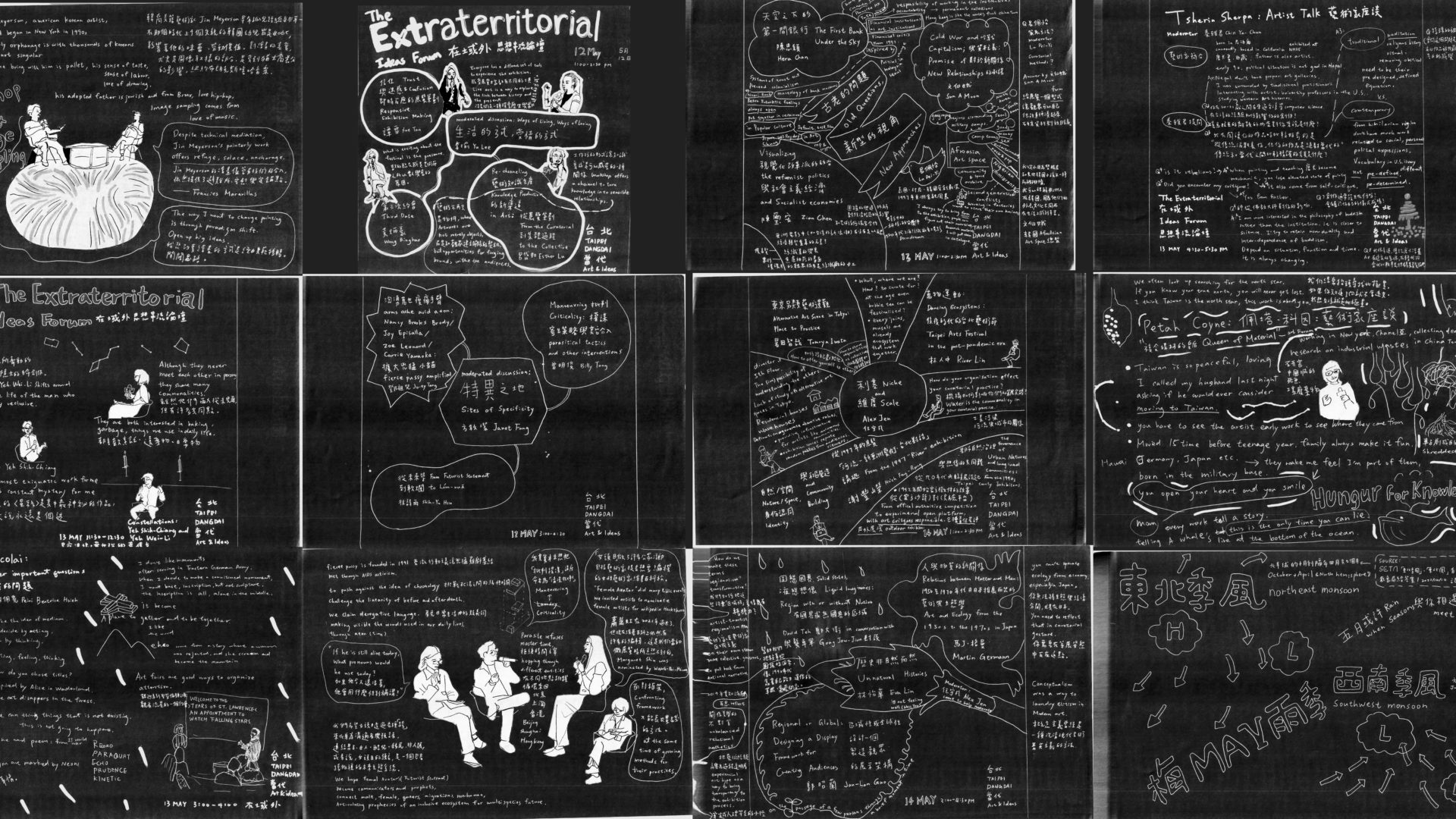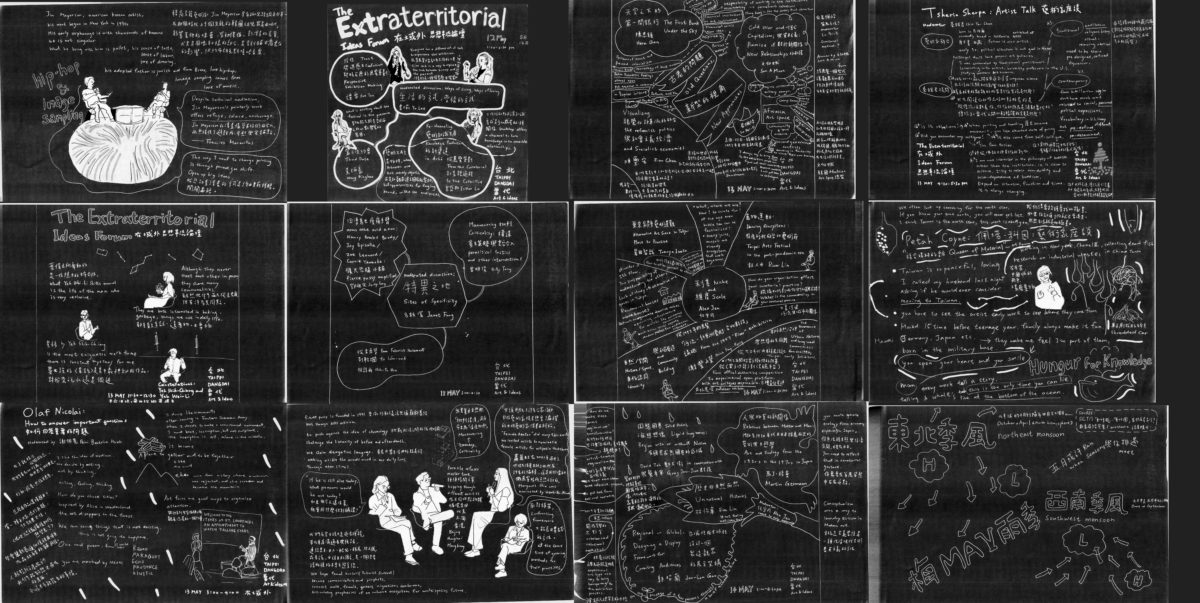台北當代藝術博覽會「在域外」思想串流論壇
漩渦總結:在域外思想串流論壇
Eddied Summary: The Extraterritorial Ideas Forum
文|吳礽喻,台北當代藝術博覽會論壇編輯
by/through Renyu, Taipei Dangdai Forum Editor
我的工作是為 2023 年台北當代藝術博覽會的論壇摘錄金句並撰寫總結,帶著對「外星人」的好奇心走進論壇一探究竟,其實除了酷愛恐龍的徐詩雨之外,我幾乎誰都不認識,直到第二天才意識到論壇的大標是「在域外」(extra-territorial),而不是之前以為的「外星」(extra-terrastrial)。領域性(territorial)是一個對立的詞,然而,如何域外,保有自己的同時又不止於此,就很有趣了。
With the curiosity of what might entail in the ‘extraterrestrial’, and knowing no one except Shih-Yu, who loves dinosaurs, I stepped into the conference room to find out more. I was briefed to capture quotes and write up a summary for the 2023 edition of the Taipei Dangdai Ideas Forum. Only until the second day did I realize the title of the forum was ‘extra-territorial’ not ‘extra-terrestrial’ that I had previously perceived. Territorial is a confronting word, however, how to be extra-territorial, retaining yourself at the same time being more than that, is interesting.
「在域外」思想串流論壇邀請九位國際策展人訪台,以及七位台灣策展人,分享亞洲藝術新視角,探討區域與文化歸屬感議題。伊斯坦堡雙年展策展人鄭大衛(David Teh)問到「我們如何使諸如『區域主義』之類的詞彙具有變革性?」,或是台灣藝評秦雅君對在尼泊爾出生、美國生活的藝術家問到「您的離散經驗的實質內涵是什麼?」 都是幫助觀眾和對話者,在物質世界中一起導航和錨定具身性和抽象概念的絕佳機會。
‘The Extraterritorial’ Ideas Forum brings nine international curators to Taiwan and seven local curators to share their work from the cutting edge of art today. Touching on issues of ‘region’ and ‘cultural belonging’, exceptional questions, such as ‘how do we make terms such as “regionalism” transformative?’ posed by David Teh, and ‘what is the substance of your diasporic experience?’ by Chih-Ya-Chun help audiences, and interlocutors navigate and anchor embodied and metaphysical materiality.
生活、愛與策展方式
Ways of Living, Loving & Curating
「感受展覽大家都有不同的工具。活藝術是一種探索歷史與當下連結的方式。」 — 譚雪,信任與迷惑 – 即時反應的展覽策劃
‘Everyone has a different set of tools to experience the exhibition. Live art is a way to explore the link between history and the present.’
— Xue Tan, Trust & Confusion – Responsive Exhibition Making
「工作坊的形式讓知識變成是可以感受的一種關係。藝術不再只是物件,而是和觀眾建立關係的契機。」 — 呂岱如,藝術知識生產的新渠道:從展覽策劃到集體過程
‘Workshop offers a channel to turn knowledge into sensible relationships. Where artworks are not merely objects, but opportunities for forging bounds with the audiences.’
— Esther Lu, Re-channeling Knowledge Production in Art: From the Curatorial to the Collective
新一代策展人追尋與觀眾協作及知識生產的方法學,以更自由的新典範來做與談藝術的多種可能。「第三次約會」講者黃炳豪以散文為方法接近藝術,為更自由美好的世界做出如星宿排列般,具有情感的閱讀感受。我似乎聽到一句引言「當下的臨在感是藝術節之所以令人興奮的原因」,加上譚雪和呂岱如的策展取徑,在博覽會的背景下,將讓我用全新視野看待這些在台北當代藝術博覽會上已然豐富的工作坊、導覽、活動。乘坐手扶梯進入刷票口,漫步於不同的參展商、展位和藝術品之間的興奮感,是否可也以成為我們反思與共同成長的機會?意想不到的對話和連結等待著你。這些是否能幫助我們成為世界上更好的生物與具有美德的拾荒者?
A new generation of curators is finding ways to engage the audiences and knowledge production, to shift the paradigms of artistic discourse with emancipatory possibilities. Apt in the fair setting, ‘Third Date’ speaker Wong Binghao approaches art essayistically, constellating emotionally available readings and experiences of art in the hope of building more emancipatory and ethical worlds. I seemed to overhear a quote ‘what is exciting about the festival is the presence’, together with the above-mentioned approaches by Xue Tan and Esther Lu, make me see workshops, guided tours, and activities, which are already abundant practices in Taipei Dangdai fair, in a different light. May the excitement of riding on the elevator and entering the front gate, meandering amongst different exhibitors, booths, and artworks, be a chance for reflecting on our collective becoming? Unexpected dialogues and bonds await. Can these help us become better critters and ethical scavengers in the world?
萬古有生
Animating aeons
「反抗編年史概念,挑戰死活之間的線性時間。」— 鄧祖兒,洶湧萬世痠痛手臂:Nancy Brooks Brody / Joy Episalla / Zoe Leonard / Carrie Yamaoka:擴大兇猛雞掰
‘To push against the idea of chronology, challenge the linearity of before and after death.’
— Jo-ey Tang, arms ache avid aeon: Nancy Brooks Brody / Joy Episalla / Zoe Leonard / Carrie Yamaoka : fierce pussy amplified
「Parasite 拒絕時間主宰,在不同地點跳躍、循環來回。北京、上海、香港……」—— 曾明俊,批判權謀 寄生策略與其他介入
‘Parasite refuses master time, hopping through different entities, circling around. Beijing, Shanghai, Hong Kong…’
—— Billy Tang, Maneuvering Criticality: parasitical tactics and other interventions
「我們邀請藝術家提名想要編輯、撰寫的女性藝術家。 當時王佩瑄提名了蕭麗虹老師。蕭麗虹在2021年過世了,但現在維基百科上依然有許多的編輯,這是我們當初做展覽時所意想不到的。」——徐詩雨,從未來學到軟爛
‘We invited artists to nominate female artists for the Wikipedia Hackathon. Margaret Shiu was nominated by WANG Pei-Hsuan. Margaret Shiu passed away in 2021, but her wikipedia page still has many edits until now. We didn’t expect that while making the exhibition.’
——Shih-Yu Hsu, Futurist Statement to lám-nuā
第二場論壇由漁光島藝術節策展人方敘潔主持,生動探討尺度、時間性、人與非人。
Moderated by Janet Fang, Curator of Yuguang Island Art Festival, the 2nd session delves into the animating questions of scale, temporarity, human and non-human.
fierce pussy 成立於 1991 年,因愛滋倡議行動而集結。反抗機構對策展人設下的種種限制、挑戰展覽作為最終目標的目的論,鄧祖兒從 2015 年開始持續與團體成員合作,從費城當代藝術博物館、巴黎東京宮,再回到紐約街頭。幾乎作為團體的第五個成員,擁抱我們日常生活可見的貶義詞,經由時間轉化為再匯聚的力量,鄧祖兒引述許多發人省思的詩與作品,包括「如果他今天還活著,他會用什麼性別的稱謂?」
fierce pussy was founded in 1991, met through AIDS activism. Jo-ey Tang pushes against institutional parameters set against curators, and challenges exhibition as the end goal. Their collaboration started from 2015 ongoing, circulating from Philadelphia (ICA) to Palais de Tokyo, Paris, and back to New York streets. Almost as the fifth member of the collective, claiming derogative language, making visible the words used in our daily lives, through aeon(time), Jo-ey speaks of many fierce poems and examples, including ‘If he is still alive today, what pronouns would he use today?’
作為鄧祖兒的老友,以及關於想像友誼的「MORE THAN LOVERS, MORE THAN FRIENDS」(不只是戀人,不只是朋友)展覽合作者,曾明俊坦承幾乎想把演講主題命名為清洗批判。寄生是面對空間與政治氣候種種不可為的應對策略,做為寄生策略與其他介入的其中一個案例,他構思了一個網站作為語言之間的橋樑。
As a long-time friend of Jo-ey Tang and collaborator of the ‘MORE THAN LOVERS, MORE THAN FRIENDS’ exhibition on imaginary friends, Billy Tang opens up that he almost wanted to name his presentation as Laundering Criticality. Maneuvering through impossibilities of space and political climate through parasitical tactics, he provisioned a website as a bridge between languages as one of the examples.
語言是本場三位演講者的共同主題之一。將生死的非線性時間巧合聯繫在一起,徐詩雨將性別資訊不對等轉化為「女頭目」在維基百科上培養欣賞他者的未來主義聲明,這種關懷也轉化為軟爛讀書會,與擔任鳳甲雙年展策展人所發布的公開徵集。
Language is a common theme among these three speakers. Threading together the non-linearity of before and after death with coincidences, Shih-yu Hsu translates the imbalance of gender representation on Wikipedia to ways of cultivating admiration for others in Female Avatars’ Futurist Statement. This care also translates into the lám-nuā reading group and Taiwan International Video Art open call at Hong-gah Museum.
語言作為特異之地,方敘潔肯定這三位講者面對框架,又能長出實踐的方法。我傾聽這些對話,思考它們如何輕輕地將未來推向更有趣、更具推測性的星宿排列方式。不知什麼時候疲憊的展覽時間性,一年五次,一年十次的規模編排,不再是噱頭?
Language as sites of specificity, Janet Fang acknowledges how they confront frameworks at the same time of growing methods for practices. I wonder when the weary exhibition temporarity, five times a year, ten times a year, and choreography of scales, are no longer stunts? I listen to these conversations and think about how they might gently push the future toward more interesting and speculative constellations.
方敘潔:非以人為中心的策展會是什麼樣子?
Janet Fang: what would non-human centric curation like?
徐詩雨:物有他的能動性是一件很有趣的事情。女頭目是跨越邊界,藝術又是最能打開人類感知邊界的手段。其實對於非人,有很多不可知性 unknownability,你需要放到你的思考中。你對你自身之外的事情,是無法完全去理解的,所以討論跨物種感知好像有點太侵略了,所以鳳甲雙年展才會回到 care 這個主題。
Shih-yu Hsu: The subjectivity of objects is an interesting issue. Female Avatars’ Futurist Statement crosses boundaries, art is the best instrument to open up human sensibility and boundaries. But you have to take unknowability into account while dealing with non-humans. You can’t fully understand things other than yourself. So to talk about trans-species issues might be too aggressive. That’s why we return to ‘care’ as a theme in TIVA.
曾明俊:成長過程中被種族歧視的經驗,讓我一直對有生論與情動感興趣。
Billy Tang: Due to the racism experienced while growing up, animism and affect have always interested me.
尋找經濟和政治姿態
Finding economic and political gestures
「我從小因為雙眼皮和其他韓國小孩不一樣而被排擠,我可以理解非洲人在韓國,因為他們的外表、文化不同而生活上感到辛苦。」— 文仙娥,冷戰與資本主義;對於新關係的承諾
‘While growing up being mocked just for double eyelids, I can empathize with how Africans struggle in Korean society because they appear different.’
— Sun A Moon, Cold War and Capitalism; Promise of New Relationships
思想串流論壇的第二天歡迎泰特美術館策展人陳思穎、首爾 SPACE AFROASIA 總監文仙娥和電影研究者陳璽安就藝術和政治經濟學的難題進行討論。
The second day of the Ideas Forum welcomed Hera Chan, Adjunct Curator at Tate Modern, SPACE AFROASIA director Sun A Moon and cinematic researcher Zian Chen on the hard topic of art and political economy.
陳思穎受到 1997 年亞洲金融風暴啟發,提出了基於個人興趣的研究計畫。她意識到銀行是在殖民主義之前就有的信任體系,進而觀察銀行博物館、相關的電影流行文化,以及受嘻哈音樂與加密貨幣啟發的藝術品,進一步反思為機構永久典藏工作應具備的責任與義務。
Hera Chan presented a research project out of personal interest, inspired by the 1997 financial crisis that impacted many Asian countries. Being aware of banks as systems of trust that proceed colonialism, she visits bank museums, films from popular culture, as well as artworks inspired by rap culture and cryptocurrency, to further reflect on the responsibility and accountability of working in an institution that has permanent collections.
文仙娥說明冷戰移民在首爾周邊創建了軍事城鎮的脈絡,以及美軍移駐後填補空缺的奈及利亞經濟移民,在工廠打工但想要創業的夢想,如何協助社區藝術空間變成現在的樣子。與社區一起製作的音樂錄影帶,活潑的非洲節奏,配上搭公車上班,戴著油漬棉手套拿東西的場景,或許就是最好的印證。她偏好把研究資料編入目錄,並總是試圖賦予展覽形式,讓人們可以在那裡弄清楚自己的故事。
Sun A Moon contextualizes how cold war migration created military towns around the periphery of Seoul. The dream of first-generation Nigerian immigrant workers, who fill in the empty spaces left by the US Army, mostly work in factories but want to start their own business, help render the community art space. A music video co-produced by the community with a lively African rhythm, accompanied by scenes of commuting on a bus and wearing greased cotton gloves to carry things, might be the best way to demonstrate how she prefers to put research materials in catalogs, and always try to bring form to the exhibition, where people can figure out their own narratives.
陳璽安與許多藝術家合作進行研究計畫。他縱覽台灣新浪潮電影中的政治和經濟動盪的痕跡及影響。台灣電影之父李行所拍攝的台語片、健康寫實片、瓊瑤文藝片,曾在紡織廠女工之間大受歡迎。他也在上海紡織廠的調研之旅中發現了 1920 年代有助於廢除剝削童工的紀錄劇情片。如果我們能夠密切觀察電影和其他聲音視覺表現中所呈現的技術和政治條件,我們或許會發現大量既有的方法來解決這些古老問題。
Zian Chen worked with many artists on research for art projects. He examines traces of affect and political and economic turbulence in Taiwan’s New Wave cinema. Lee Hsing, previously overlooked director of Taiwanese dialect films, healthy realist films, and Chiung Yao literary romantic films, actually was massively popular among female textile factory workers. He also found a 1920s docudrama that helped in abolishing child labor exploitation during a research trip to Shanghai’s textile factories. If we can observe closely to the technical and political conditions rendered in/through films and other sound visual representations, we might find a wealth of readily available approaches to these old questions.
舞動生態系的基礎設施
Infrastructural works for dancing through ecosystems
「展覽空間將『隨機大眾』與『觀眾』區隔開來。」——岩田智哉,東京另類藝術場景:實踐之地
‘Exhibition spaces separate random public from viewers.’
—Tomoya Iwata, Alternative Art Scene in Tokyo: Place to Practice
「1992 年開始官方徵件的改革,從『官方沙龍』到包含戶外展演與責任藝評制的『實驗平台』。」— 謝豐嶸,都市自然治理與想像的共同體,從九O年代北縣美展談起
‘From official competitions to open experimental platforms, with outdoor exhibitions and responsible art critics.’
— Hsieh Feng-Rong, The Governance of Urban Natures and Imagined Communities: From the 1990s Taipei County Exhibitions
「每個關節、每條肌肉已然是協助彼此工作的生態系。」——林人中,萬物運動:後疫時代的台北藝術節‘Every joint and muscle are already ecosystems that work together.’
— River Lin, Dancing Ecosystems: Taipei Arts Festival in the post-pandemic era
最後一天論壇,我們有兩個充滿活力的場次,包括新興、活潑、治理、批判、歷史、生態、重量級的策展人和思想家。
On the final day, we had two energizing panels, with emerging, dancing, governing, critical, historian, ecological, heavyweight curators, and thinkers.
東京另類藝術空間缺乏研究,岩田智哉和夥伴踏上旅程記錄這些為藝術家提供基礎設施的住宅和倉庫,並將它們與國外的替代空間聯繫起來。當主持人任宇凡問及水作為三位策展人共通主題,水如何改變策展手法?機構如何影響策展實踐?岩田智哉回答最近閱讀Astrida Neimanis的作品,開始思考如何將自己獻給他者,以及在集體中分擔責任的方式。
Due to a lack of study on alternative art spaces in Tokyo, Tomoya Iwata embarks on a journey to document these residential houses and warehouses that provide infrastructure for artists, and link them together with alternative spaces from abroad. When asked by the moderator Alex Jen, how the commonality of water as a theme influenced their curatorial practices, Tomoya replied his recent contemplation on how to offer yourself to others through reading the work by Astrida Neimanis, and how to share responsibilities as collectives.
謝豐嶸在即將開幕的新北市美術館工作,展示了政府組織的藝術活動也能十分前衛,經由眾多藝術家的努力,官方比賽成為開放的實驗平台,包括發起藝評責任制,並在戶外河邊展覽,工業污染也隨之反映在作品中。他思考河流和城市彼此如何相互形塑,當邊緣化群體通過中產階級化逐漸消失時,藝術如何產生更多樣化和有機的城市景觀。
Hsieh Feng-Rong works for the inaugurating museum at New Taipei City. He demonstrates how government organized art events can be fairly radical. Through many artists’ efforts, official competitions became open experimental platforms, initiating responsible art critics schemes, and taking exhibitions outdoors in the river. Industrial pollution was also reflected in their artworks. While marginalized groups are gradually erased through gentrification, he thinks about how rivers and cities shape each other, and how art can be generative for more diverse and organic city landscapes.
在什麼都可以節慶化的時代,甚至是珍珠奶茶,如何策劃藝術節?林人中從提莫西.莫頓(Timothy Morton)的著作〈All Art is Ecological〉汲取靈感,反思在台北藝術節和台北表演藝術中心的策展實踐、為未來制定了藍圖,將海洋與橫跨視覺藝術、舞蹈與酷兒理論研究做結合,進一步舞向萬物運動的將來。
How to curate at the age when everything, even bubble tea, can be festivalized? River Lin takes respite from Timothy Morton’s work ‘All Art is Ecological’ to reflect on his curatorial practice at Taipei Arts Festival and Taipei Performing Arts Center. He draws up a blueprint for the coming years. Fascinated with the ocean, he shares how to dance into the future as a performance artist working across the contexts of visual art, theater, and queer culture.
變革性框架
Transformative frameworks
「東南亞藝術的框架以某種方式被設定,排除了具有兩個以上身份的藝術家。我們如何讓『區域主義』這樣的詞彙具變得具有轉換力?— 鄭大衛,固態國界,液態想像:有國界或無國界的區域
‘Southeast Asia art is framed in certain ways, excluding artists who have more than two identities. How do we make these terms “regionalism” be transformative?’
— David Teh, Solid States, Liquid Imaginaries: Region with or without Nation
「你無法將生態與經濟分開,尤其在日本。你需要在策展姿態中反映這點。」— 馬丁.格曼,人與物質的新關係 – 1950至1970年代自日本推展而出的藝術與生態學
‘You can’t separate ecology from economy, especially in Japan. You need to reflect that in curatorial gestures.’
— Martin Germann, Relations between Matter and Man: Art and Ecology from the 1950s to the 1970s in Japan
「『穿越人煙罕至的小徑』反思關係美學的不對等、把藝術經驗高舉為賦予展覽過程透明度的框架」—郭昭蘭,區域性或全球性:設計一個製造觀眾的展示架構
‘Reflecting upon unbalanced relational aesthetics and experiential art hype as a way to bring transparency to the exhibition process, comes about “on the passage of a few persons through a brief moment in time.”’
—Jau-Lan Guo, Regional or Global: Designing a Display Framework for Creating Audiences
鄭大衛認為「藝術家至藝術家區域主義」幫助我們把敘事從國族拉回來,像 1990 年代靠著自己能力運作的草根、藝術家集體。
David Teh argues that ‘artist-to-artist regionalism’, where artists run on their own steam, more collective and grass-root, might help us to pull back from national narratives.
他與龔卓軍、馬丁.格曼和郭昭蘭的對話深入探討了機構歧視和遵從體制的歷史,當今藝術界缺乏熱愛一件作品到足以在糟糕情況發生時為之辯護的責任心,對當今有抱負的策展人是警醒也是鼓勵,喚醒作者角色與更具企圖心且活絡的藝術未來。
His conversation with Gong Jow-Jiun, Martin Germann and Jau-Lau Guo delves in and out of the histories of institutional conformity and discrimination. Love a work enough to defend them when shit happens is the responsibility missing in today’s art scene and reinstating the role of author is a wake up call for today’s aspiring curators.


